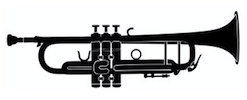Jazz consists of two parts:
- Jazz Chords (Harmony); and
- Improvisation (Melody).
To facilitate my teaching, I have further subdivided the above two facets of Jazz into Theory and Practice components. We have already discussed the Theory aspect (Jazz Chords and Jazz Scales) so it's time to discuss how to apply the theory in Practice (with Jazz Chord Voicings and Jazz Improvisation).
| Theory | Practice | |
| Harmony | Jazz Chords | Jazz Chord Voicings |
| Melody | Jazz Scales | Jazz Improvisation |
Now that we have learned some Jazz Scales and discovered how scales are related to chords, it's time to discuss how these concepts apply to Jazz Improvisation.
Jazz Improvisation is the act of spontaneously creating melody lines (usually over a given chord progression) - that is, making a melody up on the spot. Jazz Improvisation is a skill that can be learned, and contrary to the name, improvisation actually requires a lot of planning and practicing.
The overarching idea behind Jazz Improvisation is that of 'Tension' and 'Release'. You build 'tension' by playing 'wrong' notes (playing 'outside'), and you resolve or 'release' that tension by playing 'right' notes (playing 'inside'). This series of lessons will further elaborate on this general idea or framework and will give numerous Jazz Improvisation Techniques which you can employ in your own solos. These include:
- Guide Tones;
- Avoid Notes;
- Cycled Patterns;
- Side-Slipping;
- Cliches;
- and much more
The lesson on Chord Mapping will also teach you how to put the theory into practice and how to go about learning to improvise over a new song.
And once we know how to improvise, the next step is to learn some Jazz Chord Voicings, so that the chords we play don't sound boring and stale but rather sound smooth and...well, jazzy.
